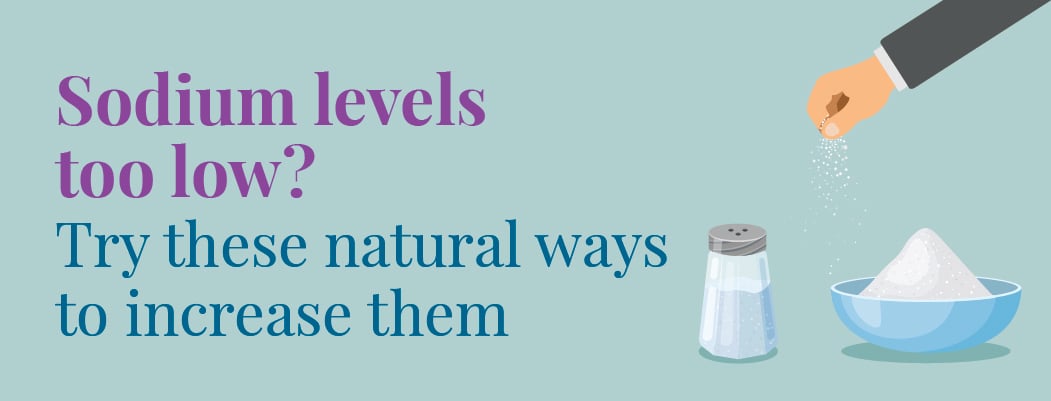How to Increase Sodium Levels
January 17, 2025

Hyponatremia, also known as low blood sodium, is a condition in which sodium concentration in the blood is lower than normal. Sodium is a mineral that plays a critical role in regulating the fluid balance in the body, transmitting nerve impulses, and maintaining muscle and nerve function. When sodium levels in the blood drop too low, it can cause a wide range of symptoms and health complications.
Causes
There are many possible causes of hyponatremia. One of the most common causes is excessive fluid intake, which can dilute the sodium in the blood. Other causes include certain medications and medical conditions that affect the kidneys or adrenal glands and hormonal imbalances.
Types of Hyponatremia
Hyponatremia is categorized based on the relationship between sodium levels and water content in the body. Understanding the type of hyponatremia is essential for identifying the underlying cause and selecting the appropriate treatment. The three main types include:
Hypovolemic Hyponatremia
This occurs when both water and sodium levels in the body decrease, but the loss of sodium is greater than the loss of water. It is commonly associated with conditions like excessive sweating, vomiting, diarrhea, or certain medications, such as diuretics.
Euvolemic Hyponatremia
In this type, total body water increases while sodium levels remain unchanged, leading to the dilution of sodium in the bloodstream. This can result from conditions such as Syndrome of Inappropriate Antidiuretic Hormone Secretion (SIADH), severe stress, or the use of certain drugs.
Hypervolemic Hyponatremia
This type involves an overall increase in both water and sodium levels, with water retention being disproportionately higher. It is often linked to conditions like heart failure, liver cirrhosis, or chronic kidney disease, where the body retains more fluid than sodium.
Symptoms of Hyponatremia
It can range from mild to severe and may include
- Headache
- Dizziness
- Fatigue
- Nausea and vomiting
- Confusion
- Being restless
- Sleepiness
- Getting irritated often
- Increased thirst
- Muscle cramps
- Lethargy
- Seizure
Treatment
Treatment for hyponatremia depends on the underlying cause and the severity of the condition. Mild cases of hyponatremia may not require any treatment, while more severe cases may require doctors’ aid to raise the sodium levels in the blood. In addition to medical treatment, addressing any underlying factors that may have contributed to the development of hyponatremia, such as excessive fluid intake or medication use, is important.
Preventing
Hyponatremia involves maintaining a healthy body balance of fluids and electrolytes. This can be achieved by staying hydrated but not overhydrating and avoiding excessive intake of fluids, especially during intense physical activity. If you are taking medications that can cause hyponatremia, be sure to talk to your doctor about the risks and potential side effects. It is also important to monitor your sodium levels regularly, especially if your medical condition puts you at risk for hyponatremia.
Hyponatremia is a condition that can have serious health consequences if left untreated. Therefore, it is important to be aware of the potential causes and symptoms of hyponatremia and to seek medical attention if you experience any of these symptoms. With proper treatment and preventive measures, it is possible to manage hyponatremia and maintain a healthy body balance of fluids and electrolytes.
Home Remedies to Increase Your Sodium Levels
If you are looking to increase your sodium levels, here are some effective ways to do so:
Increase your Salt Intake
Consuming more salt is the most straightforward way to increase your sodium levels. Salt, also known as sodium chloride, is our diet’s primary sodium source. However, it is essential to note that consuming too much salt can lead to high blood pressure, which can increase the risk of heart disease and stroke. Therefore, monitoring your salt intake and staying within the recommended daily limits is crucial.
Studies recommend consuming no more than 2,300 milligrams of sodium per day, which is approximately one teaspoon of salt. However, if you have certain medical conditions, such as hypertension, diabetes, or kidney disease, you may need to limit your salt intake further.
Consult your doctor to determine the appropriate amount of salt for your specific needs.
Consume more Sodium-Rich Foods
In addition to salt, many other foods are naturally high in sodium. These include:
- Processed and canned foods, such as soups, sauces, and snacks
- Cheese and other dairy products
- Meat and poultry
- Seafood, such as shrimp and oysters
- Vegetables, such as beets, carrots, and celery
- Condiments, such as soy sauce and ketchup
- Eat pizza with savory toppings like olives, cheese, or pepperoni
Incorporating more of these foods into your diet can help increase your sodium levels. However, it is essential to pay attention to the nutritional value of these foods and consume them in moderation.
Drink Sports Drinks or Electrolyte Solutions
If you have low sodium levels due to excessive sweating or dehydration, sports drinks or electrolyte solutions such as Gatorade may help increase your sodium levels. These drinks contain a mixture of water, sugar, and electrolytes, including sodium, potassium, and chloride. They are designed to replenish fluids and electrolytes lost during physical activity.
However, it is crucial to note that some sports drinks may contain high sugar levels, which can lead to weight gain and other health problems. Look for sports drinks with balanced electrolytes and low sugar content. As a healthy alternative, you can prefer drinking coconut water to stay hydrated.
Manage Underlying Medical Conditions
Finally, suppose you have low sodium levels due to an underlying medical condition, such as kidney disease or adrenal insufficiency. In that case, managing the condition to increase your sodium levels is essential. Depending on the specific condition, this may involve medication, dietary changes, or other interventions.
Drinking Vegetable Juice
Drinking vegetable juice such as tomato juice can be an easy way to meet your daily fruit and vegetable intake. However, it’s important to note that many packaged vegetable juices have added salt, which increases sodium levels. Therefore, fresh vegetable juice is recommended as it naturally contains healthy amounts of sodium, which can benefit your body in various ways.
You can also drink broth or bouillon, which is a good source of sodium.
Canned Vegetables
Canned vegetables are another option, but they often contain high levels of salt. To reduce the salt content, you can drain and wash them for a few minutes, which may lower their sodium levels by 9-23%. Nonetheless, fresh vegetables are always a better choice, and if you opt for canned vegetables, be sure to clean them properly.
For instance, a 100g serving of canned peas contains around 250mg of sodium, which is approximately 30-40% of the recommended daily value (DV). Similarly, a 100g serving of canned asparagus contains around 700mg of sodium, which is also 30-40% of the DV. Hence, consuming fresh vegetables is highly recommended over canned vegetables.
When to Seek Medical Assistance?
Consult with a Nephrologist for anyone who develops severe signs and symptoms of hyponatremia, such as nausea and vomiting, confusion, seizures, or loss of consciousness. Also, call your doctor if you know you are at risk of hyponatremia and are experiencing nausea, headaches, cramping, or weakness.
Summary
In conclusion, maintaining the proper sodium balance in your body is essential for your overall health and well-being. If you have low sodium levels, incorporating more sodium-rich foods, consuming sports drinks or electrolyte solutions, and considering sodium supplements can help increase your sodium levels.
Frequently Asked Questions
1. What is the recovery time from low sodium levels?
The recovery time from low sodium levels to normal can take hours or days, depending on the causes.
2. Which fruit is high in sodium?
Generally, fruits are low in sodium and are not a significant mineral source.







